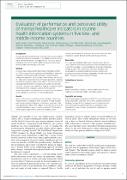| dc.contributor.author | Jordans, Mark | |
| dc.contributor.author | Chisholm, Dan | |
| dc.contributor.author | Semrau, Maya | |
| dc.contributor.author | Gurung, Dristy | |
| dc.contributor.author | Abdulmalik, Jibril | |
| dc.contributor.author | Ahuja, Shalini | |
| dc.contributor.author | Mugisha, James | |
| dc.contributor.author | Mntambo, Ntokozo | |
| dc.contributor.author | Kigozi, Fred | |
| dc.contributor.author | Petersen, Inge | |
| dc.contributor.author | Shidhaye, Rahul | |
| dc.contributor.author | Upadhaya, Nawaraj | |
| dc.contributor.author | Lund, Crick | |
| dc.contributor.author | Thornicroft, Graham | |
| dc.contributor.author | Gureje, Oye | |
| dc.date.accessioned | 2022-01-19T09:25:15Z | |
| dc.date.available | 2022-01-19T09:25:15Z | |
| dc.date.issued | 2019-08-06 | |
| dc.identifier.citation | Jordans, Mark...et al (2019). Evaluation of performance and perceived utility of mental healthcare indicators in routine health information systems in five low- and middle-income countries. Cambridge University Press. doi: 10.1192/bjo.2019.22. | en_US |
| dc.identifier.uri | DOI: https://doi.org/10.1192/bjo.2019.22 | |
| dc.identifier.uri | https://kyuspace.kyu.ac.ug/xmlui/handle/20.500.12504/257 | |
| dc.description | 7 p. | en_US |
| dc.description.abstract | In most low- and middle-income countries (LMIC), routine mental health information is unavailable or unreliable, making monitoring of mental healthcare coverage difficult. This study aims to evaluate a new set of mental health indicators introduced in primary healthcare settings in five LMIC.
Method
A survey was conducted among primary healthcare workers (n = 272) to assess the acceptability and feasibility of eight new indicators monitoring mental healthcare needs, utilisation, quality and payments. Also, primary health facility case records (n = 583) were reviewed by trained research assistants to assess the level of completion (yes/no) for each of the indicators and subsequently the level of correctness of completion (correct/incorrect – with incorrect defined as illogical, missing or illegible information) of the indicators used by health workers. Assessments were conducted within 1 month of the introduction of the indicators, as well as 6–9 months afterwards.
Results
Across both time points and across all indicators, 78% of the measurements of indicators were complete. Among the best performing indicators (diagnosis, severity and treatment), this was significantly higher. With regards to correctness, 87% of all completed indicators were correctly completed. There was a trend towards improvement over time. Health workers' perceptions on feasibility and utility, across sites and over time, indicated a positive attitude in 81% of all measurements.
Conclusion
This study demonstrates high levels of performance and perceived utility for a set of indicators that could ultimately be used to monitor coverage of mental healthcare in primary healthcare settings in LMIC. We recommend that these indicators are incorporated into existing health information systems and adopted within the World Health Organization Mental Health Gap Action Programme implementation strategy. | en_US |
| dc.language.iso | en | en_US |
| dc.publisher | Cambridge University Press. | en_US |
| dc.subject | Mental healthcare | en_US |
| dc.subject | Low- and middle-income settings | en_US |
| dc.subject | Health information system | en_US |
| dc.subject | Primary healthcare | en_US |
| dc.title | Evaluation of performance and perceived utility of mental healthcare indicators in routine health information systems in five low- and middle-income countries | en_US |
| dc.type | Article | en_US |

